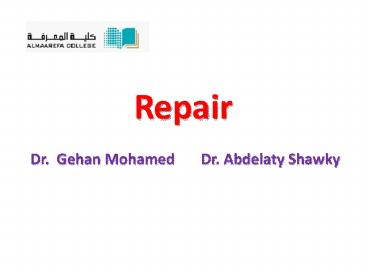Repair - PowerPoint PPT Presentation
1 / 24
Title: Repair
1
Repair
- Dr. Gehan Mohamed Dr. Abdelaty Shawky
2
Intended Learning outcomes
- Understanding the classification of human cells
according to their ability for proliferation. - Identifying the types of repair.
- Discussing the mechanism of wound healing.
- Recognizing the complications of wound healing.
- Understanding the process of healing of bone
fracture. - Being oriented with the factors affecting the
process of repair.
3
Types of cells according to the ability of cell
proliferation
- 1. Labile cells are Conteniously dividing cells
and renew themselves e.g skin epithelium
,mucosal lining of the GIT, haematopoietic cells
(blood cells ). - 2. Quiescent cells (Stable) cells divide when
there is a need e.g hepatic, kidney and pancreas
. - 3. Permanent cells Non-dividing cells so when
injured heal by fibrous tissue e.g nerve cells
and skeletal, cardiac muscle cells
4
Repair (Healing)
- Definition Replacement of damaged tissue with
new healthy living tissue. - Types
- A. Regeneration
- healing by the same type of tissue cells from
surrounding healthy living cells, this occurs
with small damages of labile cells and stable
cells for examples liver cirrhosis and bone
fractures - B. Fibrosis (scar tissue)
- healing by granulation tissue (fibroblast with
new capillaries) which mature to hypovascular
fibrous tissue (scar), this occurs in the healing
process of permanent cells or in stable cells
with high damage. for example myocardial
infraction and wounds
5
Wound Healing
- Cutaneous wound healing is generally divided into
four phases - Homeostasis.
- Inflammation.
- Granulation tissue formation and
Re-epithelialization - Remodeling.
- - Wound healing is a fibroproliferative response
that is mediated through growth factors and
cytokines.
6
1. Homeostasis
- Immediately after injury the cut vessels bleed
inside the wound defect to form a blood clot that
unit the two cut ends temporarily. - Vasoconstriction of the injured vessels at the
edges of the wound followed by platelets
aggregation and adherence to the damaged
endothelium. - Stimulation of coagulation system will form
fibrin. - Fibrin network is formed over the aggregated
platelets to form a 1ry homeostatic plug that
stops bleeding inside the wound.
7
- 2. Inflammation
- Mediated by polymorphs and macrophages.
- Within the first 6-8 hours, the
polymorphonuclear leukocytes (PMNs) kill any
organism in the wound and liquefy any necrotic
debris. - As the process continues, monocytes also exude
from the blood vessels. These are termed
macrophages. The macrophages continue and engulf
the necrotic debris and also manufacture various
growth factors during days 3-4.
8
- 3. Granulation tissue formation and
re-epithelization - In days 5-7, fibroblasts migrate into the wound,
laying down new collagen of the subtypes I and
III - Angiogenesis is the formation of new capillaries
from the healthy blood vessels at the edge of the
wound. These new capillaries fill the wound
defect and surrounded by fibroblasts. - The newly formed capillaries fibroblasts
granulation tissue. - Re-epithelization occurs by proliferation and
migration of the healthy epidermal cells from the
edges of the wound inwards.
9
Granulation tissue
10
Granulation tissue
Epithelization
capillary
fibroblast
11
- 4. Remodeling
- - After the third week, the wound undergoes
constant alterations, known as remodeling. - Collagen is deposited from fibroblasts and
degraded by collagenase enzyme which secreted
from macrophages in a controlled manner. - Wound contraction is a process occurs by the
action of myofibroblasts (modified fibrobalsts),
which resemble contractile smooth muscle cells.
This occurs to give the healing wound more
strength.
12
Types of wound healing
- 1. Healing by primary union (first intention)
- - Occurs with clean, non-gaping wounds (stitched
surgical incision). - 2. Healing by secondary union (secondary
intention) - - Occurs with extensive tissue loss as in large
wounds, infected wounds, abscess, ulcers.etc.
13
(No Transcript)
14
Complications of the healing process
- A. Complications from deficient granulation
tissue formation - 1. Ulcers discontinuity of the covering
epithelium or mucous membrane . - 2. Sinus is blind end track of septic
granulation tissue connecting a cavity to the
outside e.g. pilonidal sinus - 3. Fistula is a tract of septic granulation
tissue connecting 2 epithelial surfaces e.g.
perianal fistula. - 4. Weak atrophic scar this may lead to hernia .
15
- B. Complications due to excessive granulation
tissue formation - 1. Hypertrophied scar.
- 2. Keloid formation if the formed scar
exceeded the original size of the wound.
16
Keloid
Hypertrophic scar
17
Keloid
B
A
18
- C. Other complications
- Infection leading to delayed healing
- Squamous cell carcinoma rarely scars may develop
- Cicatrisation contracture of the size of the
scar - Implantation epidermiod cyst is a cyst formed
secondary to entrapment of part of the epithelium
inside dermis. - Stump neuroma following amputation causing a
painful coiled mass of nerves
19
Bone Fracture
- TYPES
- Simple.
- Compound .
- Comminuted fracture into pieces.
- Greenstick is a partial fracture involve only
one side of bone , common in children.
20
Types of Fracture
21
Mechanism of healing of bone fracture
22
Complications of bone fracture
- 1. Delayed union (healing) due to old age,
anaemia, calcium or vitamin D deficiency - 2. Non union due to soft tissue interposition
between the two fracture ends. - 4. Mal union of healed bones due to improper
reduction. - 5. Bone necrosis due to injury to nutrient
artery.
23
Factors affecting Repair
- I. Local factors
- The type of the damaged cells ( labile, stable or
permanent). - Severity of the damage.
- Presence of foreign body.
- Presence of necrotic tissue.
- Infection.
- Irradiation.
- Blood supply.
24
- II. General factors
- Age of patient.
- Nutrition status.
- Diseases Diabetes, malignancy, anaemia.
- Drugs Corticosteroid therapy, chemotherapy..































